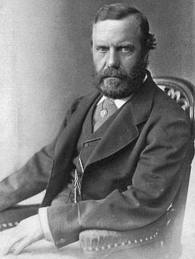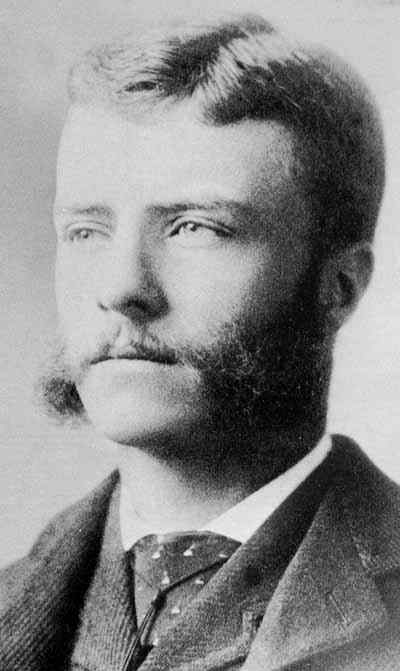This was actually a “family” undertaking.
The Father
On April 8, 1869, a formal meeting was held in the front parlor of the Roosevelt home, at 28 East 20th Street in New York City, to draft the charter that established the American Museum of Natural History.

Theodore Roosevelt Senior was a New York Knickerbocker – one of the descendants of an old Dutch family who settled in New York around 1650. They had come to seek their fortune, which became a large one, and proceeded to take a prominent role in society, both socially and morally. The family owned a large and successful plate glass company, and by the end of the Civil War, with new building projects abounding, were among New York’s millionaires.
Roosevelt Sr. was also considered one of New York’s true philanthropists. He took his Christian responsibilities seriously, and devoted both his fortune and his time to numerous charitable causes. No doubt his interest in Natural History was sincere, but it was a passion deeply ingrained in his son.
The Son
On the day of the meeting to establish the Museum of Natural History, his son, Theodore Junior, was ten years old. He was asthmatic and frail, and as such had been unable to run and play like other boys his age.

Nevertheless, his mind was clear and open, and his range of interests bordered on the phenomenal. By eight, he had begun a serious collection of leaves and rocks, insects, small critters, and especially birds. He learned their names – including their technical Latin ones – their structures and habitats and the sounds they made. He began to study taxidermy. By ten, he organized the “Roosevelt Museum of Natural History” in his bedroom.
No doubt the visitors to the Roosevelt front parlor on April 8 were invited to view the precocious boy’s collections, and nod with encouraging regard.
The Next Five Years
Serious museums, like the one the senior Roosevelt envisioned, do not take shape overnight. Deep pocketed sponsors and dedicated trustees had to be recruited, funds had to be raised, property purchased, architectural plans prepared, etc., etc. And while Father Roosevelt was deeply engaged in those activities, his son was undergoing many changes of his own.

Asthma, then as now, is a serious pulmonary condition very common to small children. It is also common, then as now, for asthma to abate considerably once the child reaches puberty. In Theodore Junior’s case it did, coupled with the dedicated effort undertaken by both father and son, to “make” the boy’s body. Gym equipment was purchased and installed in an upstairs room, and an off-duty New York policeman was hired as a part-time personal trainer.
TR (as he would later be called) was as diligent in physical education as he was in intellectual efforts, and he became the poster boy for the strenuous life. His acquired physical strength and stamina was coupled with a pair of eyeglasses to correct his nearsightedness, and by the time he was ready to enter Harvard, he was a young man to be reckoned with – on many levels.
But his interest in natural history would remain lifelong. On many levels.
The Building
For the better part of a decade, what would become the American Museum of Natural History was housed in New York City’s Arsenal, as various collections were amassed, cataloged and codified. The Arsenal still stands, as does the Museum building at 200 Central Park West, near West 77th street. Its cornerstone was laid in 1874, and opened in 1877.
While it is likely that Theodore Roosevelt Senior was present for the grand opening, he was already in poor health. He died of cancer in early 1878, at only 46. His son was nineteen.
As one would imagine, in the course of 150 years, that building has been expanded and revamped several times, and now encompasses 27 interconnected buildings plus the world-famous Hayden Planetarium and a significant library.
It also houses the small “Roosevelt” Museum that TR had begun when he was a child. A formal two-story Memorial was commissioned and dedicated to TR a few years after his death in 1919.
TR: The Complicated Conservationist
Theodore Roosevelt was undeniably a man who loved hunting as a sport, and throughout his adult life he made time to camp and hunt and enjoy nature in all its forms. His home at Sagamore Hill is filled with massive trophies.
He was also a dedicated conservationist, and during his presidency he created countless preservation sites to protect them against the intrusions of mankind. Those acts were not only his most lasting legacy, but perhaps the ones he treasured most.
There is a wonderful story about POTUS TR on a camping trip out west with a small party. They discovered a “previously unknown” type of desert rodent. It fascinated the President, who immediately shot it. And while his companions enjoyed the benefits of nature for the rest of the day, TR spent the the time with his dissecting tools and slides, preparing his newfound specimen for scientific research. It was said that his methodology was flawless. And he had such a good time doing it!
We tend to forget that TR, the naturalist, was extremely knowledgeable in botany, zoology, ornithology, and related sciences, but in the nineteenth century, there were few avenues for monetary gain, and even fewer where he might “make his mark” – something important to him. Today, TR could easily have a career as a naturalist. And probably a TV series.
He would be the first to remind people that “critters” are needed for scientific study, the same way cadavers are needed to teach medical students.
TR, with his broad outlook and multi-interests also knew they are not incompatible.
Sources:
Miller, Nathan – Theodore Roosevelt: A Life – William Morris, 1992
Morris, Edmund – The Rise of Theodore Roosevelt – Coward McCann, 1979
https://millercenter.org/president/roosevelt/life-before-the-presidency




Very interesting and well written, Ms. Foster. Thanks for taking the time to do it.
Reblogged this on Dave Loves History.
Pingback: No. 680: Let's go to the zoo (with Betty Ford, Admiral Yamamoto and the Buddha) - Innovate Long Island